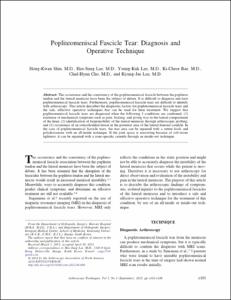KUMEL Repository
1. Journal Papers (연구논문)
1. School of Medicine (의과대학)
Dept. of Orthopedic Surgery (정형외과학)
Popliteomeniscal fascicle tear: Diagnosis and Operative Technique
- Keimyung Author(s)
- Bae, Ki Cheor; Cho, Chul Hyun; Lee, Kyung Jae
- Department
- Dept. of Orthopedic Surgery (정형외과학)
- Journal Title
- Arthroscopy Techiques
- Issued Date
- 2012
- Volume
- 23
- Issue
- 1
- Abstract
- The occurrence and the consistency of the popliteomeniscal fascicle between the popliteus tendon and the lateral meniscus have been the subject of debate. It is difficult to diagnose and treat popliteomeniscal fascicle tears. Furthermore, popliteomeniscal fascicle tears are difficult to identify with arthroscopy. This article describes the diagnostic factors for popliteomeniscal fascicle tears and the safe, effective operative techniques that can be used for their treatment. We suggest that popliteomeniscal fascicle tears are diagnosed when the following 3 conditions are confirmed: (1) existence of mechanical symptoms such as pain, locking, and giving way in the lateral compartment of the knee; (2) identification of hypermobility of the lateral meniscus through arthroscopic probing; and (3) occurrence of an osteochondral lesion in the posterior area of the lateral femoral condyle. In the case of popliteomeniscal fascicle tears, the tear area can be repaired with a suture hook and polydioxanone with an all-inside technique. If the joint space is narrowing because of soft-tissue tightness, it can be repaired with a zone-specific cannula through an inside-out technique.
The authors report that they have no conflicts of interest in the authorship and publication of this article.
- Publisher
- School of Medicine
- Citation
- Hong-Kwan Shin et al. (2012). Popliteomeniscal fascicle tear: Diagnosis and Operative Technique. Arthroscopy Techiques, 23(1), e101–e106. doi: 10.1016/j.eats.2012.04.004
- Type
- Article
- ISSN
- 2212-6287
- Appears in Collections:
- 1. School of Medicine (의과대학) > Dept. of Orthopedic Surgery (정형외과학)
- 파일 목록
-
-
Download
 oak-aaa-00423.pdf
기타 데이터 / 1.78 MB / Adobe PDF
oak-aaa-00423.pdf
기타 데이터 / 1.78 MB / Adobe PDF
-
Items in Repository are protected by copyright, with all rights reserved, unless otherwise indicated.